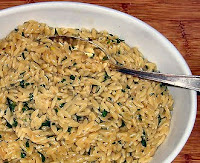 We love Rosemary-infused olive oil for drizzling on lamb, white beans and for dipping with good Italian bread. As I was trimming our rosemary this morning, I realized that we are out of our favorite oil, so I decided to try my hand at making some at home. My kitchen now smells like a Tuscan cucina!
We love Rosemary-infused olive oil for drizzling on lamb, white beans and for dipping with good Italian bread. As I was trimming our rosemary this morning, I realized that we are out of our favorite oil, so I decided to try my hand at making some at home. My kitchen now smells like a Tuscan cucina!½ cup rosemary leaves
1 cup extra-virgin olive oil
Start by wiping down fresh rosemary with a damp towel, and removing the leaves from the woody branches. Place rosemary and olive oil in a food processor and pulse to cut up leaves and release their natural oil. Place the olive oil mixture in a sauté pan on the lowest heat setting on your stovetop. Allow rosemary olive oil mixture to heat slowly and simmer for 5-7 minutes, then remove from the heat. Do not let rosemary brown in the oil else it will taste bitter. Allow the oil to cool and then pour oil through a sieve lined with cheese cloth or a paper coffee filter. Transfer the rosemary oil to a clean bottle and refrigerate. The oil may get cloudy in the refrigerator, but it will become clear again at room temperature. The full flavor and fragrance of the oil is at its peak at room temperature.










